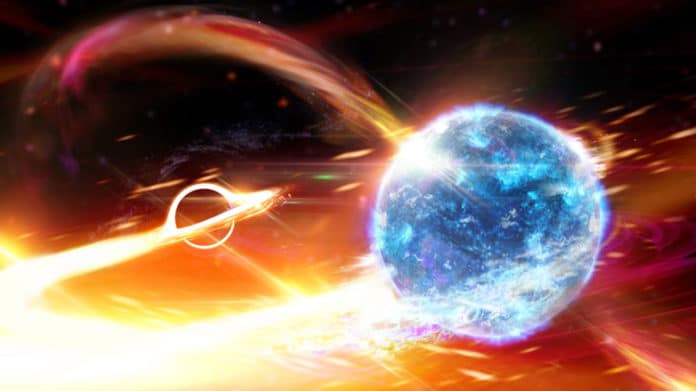The most massive stars die, they collapse under their gravity and leave behind black holes—the death of stars that are less massive than this leading to neutron stars.
For decades, scientists are trying to understand this gap that lies between neutron stars and black holes.
The most massive known neutron star is no more than 2.5 times the mass of our sun or 2.5 solar masses, and the lightest known black hole is about five solar masses. The question remained: Does anything lie in this so-called mass gap?
Scientists from the National Science Foundation’s Laser Interferometer Gravitational-Wave Observatory (LIGO) and the European Virgo detector, scientists have reported about the discovery of an object of 2.6 solar masses, placing it firmly in the mass gap.
Originally discovered on Aug. 14, 2019, the object was detected using LIGO and VIRGO as merged with a black hole of 23 solar masses, generating a splash of gravitational waves.
This cosmic merger dubbed as GW190814, and the event resulted in a final black hole about 25 times the mass of the sun. The black hole lies about 800 million light-years away from Earth.
Co-author Patrick Brady, a professor at the University of Wisconsin, Milwaukee, and the LIGO Scientific Collaboration spokesperson, said, “This is going to change how scientists talk about neutron stars and black holes. The mass gap may, in fact, not exist at all but may have been due to limitations in observational capabilities. Time and more observations will tell.”
Before the two objects merged, their masses differed by a factor of 9, making this the most extreme mass ratio known for a gravitational-wave event, the unequal masses of the system allowed the scientists to measure higher harmonics or higher multipoles of gravitational radiation in the underlying signal. This is a wonderful validation of General Relativity, which predicts the multipolar structure of gravitational radiation.
Vicky Kalogera, a professor at Northwestern University, said, “It’s a challenge for current theoretical models to form merging pairs of compact objects with such a large mass ratio in which the low-mass partner resides in the mass gap. This discovery implies these events occur much more often than we predicted, making this an intriguing low-mass object.”
“The mystery object may be a neutron star merging with a black hole, an exciting possibility expected theoretically but not yet confirmed observationally. However, at 2.6 times the mass of our sun, it exceeds new predictions for the maximum mass of neutron stars, and may instead be the lightest black hole ever detected.”
After the detection of the object, scientists reanalyzed the event, including the data from the LIGO Hanford detector. Having data from three detectors significantly improves the sky localization, which in turn helps the electromagnetic follow up. In this case, the new localization was about 20 times smaller than the original localization.
Surabhi Sachdev, an Eberly Postdoctoral Research Fellow at Penn State and a LIGO team member said, “The reanalysis needed to be as quick as possible after we were told that the data from LIGO Hanford was okay so that we could send updated sky localizations to astronomers not wanting to miss out on precious observing time.”
Dozens of ground- and space-based telescopes followed up in search of potential optical or infrared radiation generated in the event, but none picked up any such radiation. So far, such optical and infrared counterparts to gravitational-wave signals have been seen only once, in a game called GW170817.
That event, discovered by the LIGO-Virgo network in August of 2017, involved a fiery collision between two neutron stars that was subsequently witnessed by dozens of telescopes on Earth and in space. Neutron star collisions are messy affairs with matter flung outward in all directions and are thus expected to shine with light. Conversely, black hole mergers, in most circumstances, are thought not to produce light.
According to the LIGO and Virgo scientists, the August 2019 event was not seen in light for a few possible reasons. First, this event was six times farther away than the merger observed in 2017, making it harder to pick up any light signals. Second, if the collision involved two black holes, it likely would not have shone with any light. Third, if the object was a neutron star, its 9-fold more massive black-hole partner might have swallowed it whole; a neutron star consumed whole by a black hole would not give off any light.
Ryan Magee, a graduate student at Penn State and a member of the LIGO group, said, “I was shocked when I pulled up GraceDB (Gravitational-Wave Candidate Event Database) to look at the estimated masses. One of my primary interests is the formation of compact objects at masses inaccessible to conventional processes, so I was thrilled to see a candidate like this roll in. It will have a profound impact on our understanding of compact objects.”
How will researchers ever know if the mystery object was a neutron star or black hole?
Future observations with LIGO-Virgo and possibly other telescopes may catch similar events that would help reveal whether additional objects exist in the mass gap.
Journal Reference:
- R. Abbott et al., 2020 ApJL 896 L44. DOI:10.3847/2041-8213/ab960f
